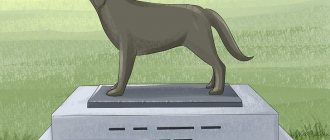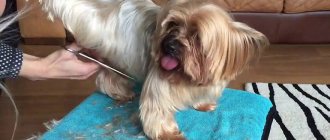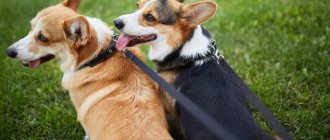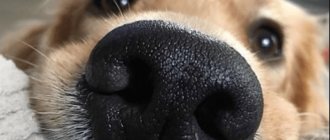What is euthanasia in dogs
The literal translation of this term is “good death.” This refers to the approach of death through the influence of third, uninterested parties on it. In this case, it is the veterinarian who confirms the need for euthanasia and carries it out. Confirmation of the need for euthanasia occurs only after all possible types of treatment have been used and a complete examination of the animal.
How to humanely kill a dog? The main principle of euthanasia is painlessness. The sick animal is given anesthesia and then a sedative. There are many types of the latter. There is a list of strictly prohibited methods of killing an animal as euthanasia: drowning, suffocation, euthanasia with potent poisons and electric shock.
Euthanasia is common in the fight against homeless animals. Many animal rights activists oppose such methods of getting rid of stray dogs, but, for example, in the United States, about five million stray animals are killed in this way every year. A similar trend is observed in European countries.
Signs of a dog dying soon
Dogs rarely die suddenly from natural causes. We can observe the process leading to the inevitable over several weeks, months and even years. Because every dog is unique in its own way, the signs of impending death are also unique to each pet. They usually affect behavior and change physical and psychological states.
Some owners prefer to resort to euthanasia so that the dog does not suffer. Others care for the pet until the end of its days. And many owners ask the question of what is best to do in their particular case. Veterinarians suggest looking at it from this angle: does the dog have more happy days or does it experience pain and depression more often? The answer to it will prompt the right decision.
In what cases is euthanasia necessary?
There are several good reasons for using euthanasia.
Incurable diseases
Pets may develop an incurable disease, leading to a long, painful and painful death of the animal. Most often, this is oncology that cannot be treated. The last stages of tumor development bring severe suffering to the pet due to the growth of metastases in vital organs. During this period, the pet loses appetite, weight and normal breathing.
Chronic renal failure is also dangerous for dogs. In the final stages of the disease, the kidneys fail, which leads to a stop in the cleansing process of the body, slow poisoning, convulsions and coma.
Aggression
The dog owner is certainly responsible for aggression in dogs. But sometimes uncontrolled behavior of an animal occurs, which poses a threat to the lives of others and requires the use of extreme measures.
Non-life-threatening injuries
If a dog receives serious injuries (for example, after an accident), there is a risk of an unfavorable prognosis for the future existence of the pet. If treatment does not help and the animal is in excruciating pain, then euthanasia is the only humane solution.
Decreased appetite
Your dog may begin to eat less and may have difficulty finishing his daily food. This decreased appetite may result from certain types of cancer treatment or from a terminal illness. Dogs with cancer may have nausea from chemotherapy, or they may not have much of an appetite due to certain tumors pushing through their digestive tract, thus requiring less food. Dogs with mast cell tumors may also have decreased appetite due to the fact that these tumors release histamines, which cause increased stomach acid production and nausea.
- Uninterested in food: It is natural for dying dogs to have a decreased appetite. The body simply no longer needs energy from food as it once did. Dogs may experience a lack of appetite out of the blue or may go through cycles of normal and abnormal appetite.
- Picky Food: Many dogs will readily eat cookies, treats, or people food, but may be turned off by kibble or dog food. Some dogs can only eat heated food. Other dogs may develop some new quirks, such as only eating if they are hand-fed or only if food is placed on the floor.
As dog owners, we are very saddened by their loss of appetite because we associate feeding our dogs food and caring for them. For dogs on medication, food is often used to hide capsules and tablets. Medicine can become especially unpleasant when food is no longer needed. Dog owners often have to get extra creative to get their dogs to take the pills.
Euthanasia in a veterinary clinic
This procedure requires medical skills and high responsibility. It must be performed by a qualified veterinarian. The process includes two stages:
- deep anesthesia of a sick animal, allowing it to fall asleep and stop feeling anything;
- administration of a potent drug that stops the functioning of the heart.
Important! Injecting the drug without anesthesia is illegal.
What allows a beloved pet to die painlessly? Veterinarians use drugs that allow the dog to be killed as comfortably as possible. The most commonly used anesthetics, sedatives, muscle relaxants, and lidocaine.
The existence of the possibility of euthanasia for dogs is very important, since this is the only possible method of painless death for a pet. The humaneness of the process also lies in the fact that the owner can be with the pet all the time in order to make him feel calmer and more comfortable. By the time the doctor administers the lethal injection, the animal is calm and no longer feels anything.
Of course, deciding to euthanasia is difficult for dog owners. As for the cost of the procedure, it directly depends on the size of the animal. The larger the dog, the higher the price tag for the service. For example, euthanizing a pet weighing up to ten kilograms will cost about one and a half thousand rubles, while euthanasia of a large dog will cost four to six thousand.
When should you euthanize your dog?
The key in this situation is to determine how much pain the animal is feeling. To evaluate the pain scale, we use the Modified Glasgow Pain Scale, in which the doctor or caregiver evaluates the following:
- The dog's behavior is calm, moans, growls, howls.
- If the animal has a wound or painful area, does it ignore it?
- If we take the dog on a leash, what does the walk look like? Normal, limping, slow or reluctant to move, rigid, refuses to move.
- If the animal has a painful area or wound and is subjected to light pressure, the dog does nothing.
- The dog is usually quiet, irresponsible, upset or fearful, stupid, or unresponsive to stimulation.
- How would you rate your dog's comfort overall? Okay, he can't find his place, he's restless, crooked or in a tender, rigid position.
Points in each category are added from 0 to 5 (in some categories up to 3 or 4) for a total of 20 (if the animal's behavior cannot be assessed) or 24. If the dog scores 5/20 or 6/24 points, then pain medication must be administered. If the pain is severe and chronic and your pet is not responding to treatment, you should talk to your doctor and consider humane euthanasia.
This very simple decision gives us key information about the dog's comfort and the need to make further decisions.
All options must be considered, with the benefit of the animal being the primary consideration. Unfortunately, some keepers ignore pain symptoms or fail to recognize them, leaving the animal exposed to chronic suffering and pain
It is important that euthanasia is also an option that the owner should be aware of
How to euthanize a pet at home
Euthanasia of a dog without certain medical knowledge and skills is impossible. But many experts believe that performing the procedure at home will make it more comfortable for both the sick animal and its owner.
What is the cost of euthanizing a dog at home? Typically, the price for providing services in such conditions additionally includes a home visit from a qualified veterinarian who has the ability and skills to perform euthanasia correctly and painlessly. Carrying out euthanasia at home will provide peace of mind to the sick animal and the absence of stress from transportation.
Is it possible to euthanize a dog yourself? It is worth noting that you need to carry out such a procedure yourself only if you have a veterinary education and experience in providing such services. For example, experienced breeders are able to choose the right drug and may know how to properly euthanize an animal, but without education it will not be easy to make injections painlessly for the pet. Therefore, it is better to entrust the euthanasia of the dog to a veterinarian.
In some sources you can find information on how to properly kill a dog. You can read in the public domain that a dog can be euthanized with lidocaine, but attempting to administer the drug on your own can cause severe pain to the pet.
Based on the above, the best solution would be to invite a veterinarian to your home. A specialist will competently and quickly carry out the procedure, which will save the animal from unnecessary suffering and the owner from stress and worry about the pet.
Results
It is impossible to accurately answer how much it costs to euthanize a dog, since the price of the procedure depends on the weight of the dog, its condition, the price of the chosen drug and whether you invite a doctor to your home. On average, for dogs up to 20 kilograms, euthanasia in a clinic costs from 1,500 rubles, and calling a specialist to your home costs from 700 rubles. Only the veterinarian who will perform the procedure will tell you the exact price.
Be strong, do not put the cost of your soul as a priority, when the question is about alleviating the suffering of your four-legged friend, it is better to let him go without pain than to see him suffer every day.
Pros and cons of euthanasia
The main advantage of euthanasia is the painless death of your pet. An owner who loves his dog is unlikely to be able to watch him suffer from a progressive disease or excruciating pain after an injury. In such cases, the euthanasia procedure is justified.
A pet can live a long life with an existing disease or injury, but all this time the dog will feel severe pain, which will bring unbearable mental pain to the owner. Of course, the process of euthanasia is a difficult test for the owner, which he is unlikely to ever forget. But experts advise to perceive this procedure as a gift of relief to the animal, and not its killing.
In particular, euthanasia is the only humane solution if a dog has rabies. Despite the fact that the animal does not suffer during this period of time, it poses a threat to the life and health of surrounding people. This disease is fatal to humans, and anyone can become a victim of a dog with rabies: a passer-by, a child, an owner.
Animal rights activists emphasize that people do not have the right to decide whether an animal lives or not. In their opinion, any living creature should die a natural death and euthanasia is considered a crime.
This opinion exists, but there is no legal prohibition on carrying out the procedure and the decision on its implementation is made only by the doctor and the pet owner. If a dog owner contacts the clinic with a request to carry out a procedure without a good reason (the animal is tired, it is not needed, it is in the way), then a qualified doctor will refuse. However, in the pursuit of profit, some specialists may agree to perform euthanasia, which is a definite disadvantage.
Unfortunately, there is a tendency to euthanize animals in nurseries that do not have free enclosures. In addition, the procedure is often carried out without anesthesia. Open access to drugs and the absence of a ban on euthanasia in such situations are certainly a disadvantage. The issue of euthanasia has been debated for many years. Pet owners have the right to protect them and have the opportunity to make their lives easier. But animal rights activists have been trying for years to prove that even dog owners do not have the right to decide whether to live with them or not.
Both opinions are justified and have a right to exist. The only possible solution would be to adopt a law banning euthanasia on healthy animals, which would limit the rights of the veterinarian and allow the procedure to be carried out only in the following cases:
- the animal has a fatal disease or excruciating pain;
- the presence of an injury that brings excruciating pain;
- presence of rabies;
- presence of a threat to surrounding people.
Also, it would be necessary to take into account the possibility of euthanizing animals only with approved drugs using anesthesia.
Currently reading:
- Is it worth it or not to include natural food in your dog’s diet?
- Seven Signs and Remedies for Getting Rid of Fleas in Dogs
- Tips for proper dog burial
- The American Cocker Spaniel is an adroit hunter and loyal friend.
Signs of a dog's death
Let's focus mainly on older and chronically ill dogs. The death of dogs, like other animals, is a process that continues and occurs gradually. In emergency situations, the dog's condition can worsen within an hour or even minutes.
- As in humans, the majority of causes of death are cardiopulmonary failure. First of all, the animal loses interest in the environment and people, reacts less to its name and does not want to go outside. He is not interested in his favorite food and toys, he does not want to play. He may even become completely unresponsive to you and your family. This is associated with decreased brain function, which can also lead to dementia.
- Before death, the dog seems to be separated from reality in its world. This can be difficult. It must be remembered that despite this condition, the animal still feels the same as before, but it does not have the power to show it to us as before.
- Then comes a loss of energy and severe fatigue. The dog begins to lie in the den, moves less willingly, and seeks a quiet and calm place. This is not necessarily his favorite lair. Sometimes the dog can't even lift his head. If it does move, it only slows it down; it could simply be a sign of aging or chronic illness. This is the time to talk to your veterinarian and differentiate between the two.
- Another problem is loss of urine and fecal control. An animal can settle in a den because it simply cannot get up. If this situation arises, do everything to keep the dog clean. Don't allow cold sores and sores to form, which will immediately infect your dog.
- A dying dog may also lose his appetite completely. No matter what you give him his favorite treats, the dog may not want to eat or drink. The closer to death, the less the animal wants to eat. If the dog stops eating completely, this is a sign that the end is near.
- The last phase is labored or shallow breathing. Shortness of breath or irregular breathing may occur, or the time between inhaling and exhaling may increase or decrease. The more symptoms mentioned above, the closer your friend is to death.
Internal organs slowly stop working, the body no longer needs water and food, appetite decreases, and vomiting or diarrhea may occur while eating. The dog loses weight and becomes dehydrated. In this case, owners often feed and water their dog from a syringe.
If your dog reaches an older age and exhibits a combination of these symptoms, it is an indication that he is approaching death. The best solution is to visit a doctor who, in the clinical test itself, is able to determine whether the animal is simply sick or dying without additional tests.
Signs after the death of a dog
If you want to get a new pet to replace the lost one, it is not recommended to do this before 2 months have passed. This is due to the belief that a puppy can suddenly get sick and die.
In ancient times, it was customary to burn a person’s dead friends. This was done so that the spirit of the beast could not rise from the grave and harm other pets. Although this could rather be explained by the fact that the burned corpse did not become a breeding ground for viruses and diseases.
Whether to believe in all these signs or not is everyone’s business. One thing is for sure - after the death of a pet, it must be buried. Moreover, in such a way that it does not get washed away during the rain and other homeless animals do not get to it.
It is best to take the dog somewhere outside the city, where there are no prying eyes. Regardless of the breed, a devoted friend needs his own grave. What you definitely shouldn't do is throw the corpse in the trash.
At the hour of death, a faithful friend needs his owner especially strongly. It’s worth remembering how much joy and fun the dog has brought to a person over all the past years and just being with him. After all, for a person he is just an episode in life, but for a pet, the owner is his whole life.
Signs of a dog's death
Let's focus mainly on older and chronically ill dogs. The death of dogs, like other animals, is a process that continues and occurs gradually. In emergency situations, the dog's condition can worsen within an hour or even minutes.
Internal organs slowly stop working, the body no longer needs water and food, appetite decreases, and vomiting or diarrhea may occur while eating. The dog loses weight and becomes dehydrated. In this case, owners often feed and water their dog from a syringe.
If your dog reaches an older age and exhibits a combination of these symptoms, it is an indication that he is approaching death. The best solution is to visit a doctor who, in the clinical test itself, is able to determine whether the animal is simply sick or dying without additional tests.
Parvovirus enteritis
An infectious disease characterized by an acute course. The source of infection is a virus that is secreted by sick and recovered dogs. At the same time, personal contact with the virus carrier is not necessary; it is easily spread in the external environment and can be carried home on a person’s shoes and clothes. The percentage of animal deaths from parvovirus enteritis is very high.
Symptoms of enteritis:
- vomiting with blood;
- diarrhea, feces with mucus and a strong foul odor;
- dehydration;
- sunken eyeballs;
- dry skin that has lost its elasticity;
- painful stomach;
- temperature increase;
- heart failure.
At risk are puppies under one year old and older dogs. In this category of animals the disease is especially severe and often ends in death. If your pet is vaccinated, then even if it gets sick, the disease will be mild and non-dangerous.
How to deal with loss
Some people recommend “getting a new dog.” The fact will probably entail that the feeling of emptiness will be replaced by other pleasant feelings, but it is absolutely impossible to say that we have experienced mourning, that we have feelings that arose as a result of the loss we have experienced.
Simply put, it is worth opening up to what is happening, sadness, sadness and longing. These are difficult feelings, but adequate and do not mean that something bad is happening to the person who experienced the loss. This is a normal and adequate reaction. Psychotherapists are always more worried when a person who has experienced a loss does not feel anything when they say that this is life and you need to move on.
After losing a friend, it is always important to have the support of loved ones. Talking helps
If we live in a way that builds social capital, creates close relationships, we will definitely find someone who wants to listen to us.
Genetic abnormalities of the musculoskeletal system of dogs
By crossing breeds and modifying them, dog handlers developed new breeds of dogs used in a specific situation. For example, the dachshund was created to hunt badgers and has the ability to easily penetrate their burrows. But this is one side of the breed's abilities.
The second is the risk of developing a disease characteristic of dogs with a long spine - displacement of the intervertebral discs with further weakening of the hind legs.
So, hereditary pathologies of the musculoskeletal system include:
- hip dysplasia;
- Lagg-Calv-Perthes disease;
- osteochondrosis;
- displacement of intervertebral discs;
- deformation of the cervical vertebrae;
- elbow dysplasia;
- displacement of the head of the radius.
A common deviation is hip dysplasia, or the discrepancy between the cup of the hip joint and its head and the incorrect insertion of the neck of the femur.
Hip disorder was first studied in German Shepherds with a diagnosis described in 1935. Based on the existing picture of the disease, dysplasia was identified in almost all large breed dogs. These are Great Danes, Bulldogs, Chow Chows, Boxers, Rottweilers, Labradors, St. Bernards, and Newfoundlands. Greyhounds and, to a lesser extent, small breed dogs are not predisposed to this disease.
Symptoms of the pathology include: rapid fatigue, gait disturbances, difficulty walking up stairs
If you do not pay attention to the first signs of the disease and neglect to contact a veterinary clinic, then in the future the pet may develop lameness up to complete loss of mobility
Lagg-Calv-Perthes disease occurs in small breed dogs: Pekingese, French bulldogs, schnauzers, toy poodles, Spitz. The pathology is a disruption of the blood supply to the femoral head and leads to necrosis of the femur.
The first symptoms are barely noticeable: mild pain in the joint, slight limping, dragging of the paw. Any deviation in the animal’s behavior should be a reason for urgent contact with a veterinary clinic.
Osteochondrosis in dogs is associated with damage to the cartilage of the intervertebral discs. The degree of inheritance is quite high and exceeds 50 percent. Breeds of large, fast-growing dogs at risk: Rottweilers, Newfoundlands, St. Bernards, Bernese Mountain Dogs, Labradors.
Displacement of intervertebral discs occurs both in breeds prone to this disease (Dachshund, Pekingese) and in older dogs of large breeds (Labrador, German Shepherd). The animal may experience pain or unsteadiness of gait, the hind legs do not obey or are paralyzed.
To diagnose the disease, it is necessary to conduct an examination at a veterinary clinic. As a rule, this is a magnetic resonance or computed tomography scan that detects damage to the spinal cord and intervertebral disc.
Deformation of the cervical vertebrae is typical for breeds with a narrow vertebral line: chow chows, Dobermans, small breeds. The characteristic pain associated with the disease is pain in the neck, in which the dog holds its head in an unnatural position with a downward tilt.
Coordination of movements may also be impaired in animals. Help in these circumstances will be a neurological examination in a veterinary clinic using modern diagnostic methods: computed or magnetic resonance imaging, myelography.
Elbow dysplasia is a physical deficiency in the formation of the elbow joint and surrounding tissues. The following breeds are at risk: German Shepherds, Rottweilers, Bloodhounds, Mastino-Neapolitans, Golden Retrievers, St. Bernards, Bernese Mountain Dogs.
Symptoms include lameness and pain when bending the paw. If you consult a veterinarian in a timely manner, the disease is curable, often requiring surgical intervention.
Congenital displacement of the head of the radial bone (dislocation of the elbow) occurs due to a genetic defect and is typical for dogs of small breeds: Yorkshire terrier, Pekingese. A sign of an abnormality is lameness or an unnatural gait of the pet with tucking its paw.
An accurate diagnosis with an x-ray examination of the pet in a veterinary clinic will determine the diagnosis and help the animal overcome the disease. Otherwise, if the disease is advanced, the dog may lose mobility.
Caring for an elderly animal
The old age of a beloved animal can approach unnoticed by the owner himself. However, this is inevitable. It will be good if a person can devote more time to his old friend. It is recommended to spend more time outdoors, remember to eat properly and visit a doctor regularly.
The latter is especially important. After all, as has been said more than once, a dog’s old age is accompanied by a number of concomitant diseases that can be identified in the initial stages
An important question that worries the owners is why the dog died in one day? There are quite a lot of options. It could be:
Some illnesses, such as cancer or breast inflammation, can take a very long time to develop and are almost unnoticeable. The pet’s condition simply deteriorates at one point and it begins to rapidly die. Lymphoma is also dangerous and almost invisible. What does this mean? And you need to find out about terrible diagnoses in advance. This is the only way to help your pet live longer and not experience severe pain.
As for nutrition, it is recommended not to skimp on food or prepared food. There is no need to say that an animal must eat high-quality food throughout its life.
In old age, special attention should be paid to this. In particular, if the dog eats ready-made food, then it should be premium and super-premium class.
Caring for an old dog











